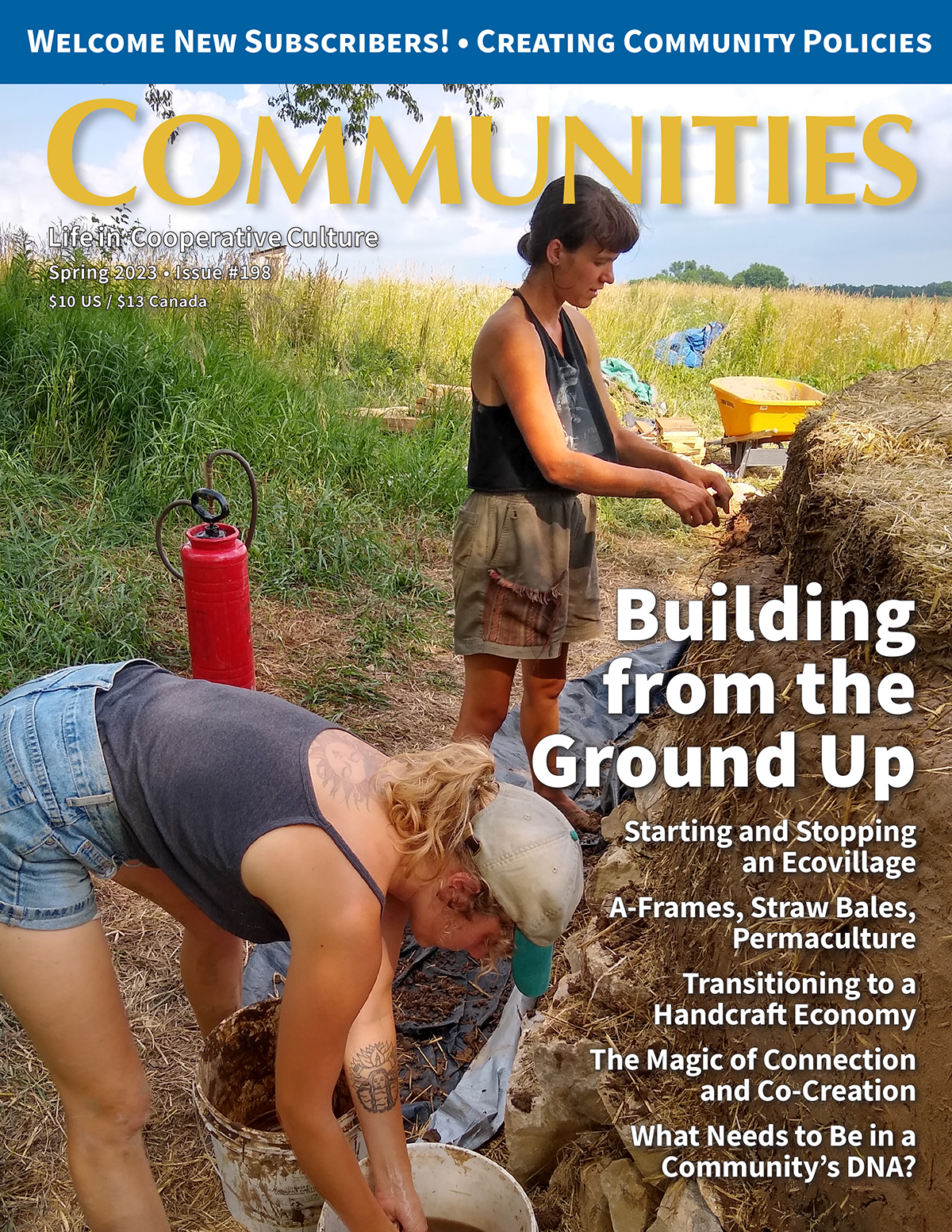
Communities #198
Spring 2023
Note: You can order a copy of this issue here.
Communities #198, Building from the Ground Up, shares stories and guidance about natural building, starting new groups from scratch, and developing communities both ecologically and socially. From A-frames in the Canadian wilds to straw bale structures, reusing old buildings to fabricating domes, going back to the land to reclaiming handcraft skills, confronting the challenges of community formation to creating effective governance, countering structurelessness to defanging challenging behaviors, we learn how individuals and groups have learned to create foundations for success.
BUILDING FROM THE GROUND UP
Notes from the Editor: Emergent Properties, Widening Circles by Chris Roth
Sharing can multiply the effects of generosity and remind us that community-focused nonprofits themselves all benefit from cooperation. Plus: we welcome new readers!
Letters: The Long Haul, The Dawn of Everything and Today, Being the Change, Speak Up Before Fleeing, New Laws Incentivize Urban Community by Arjuna da Silva, Andrew Moore, Denise Henrikson, Kara Huntermoon, Brad Gunkel
A-Frames by Carol Ladas Gaskin
Friends set out to live the simple life together amidst the lodgepole pines of British Columbia. Fifty-five years later, their “temporary” A-frames are still standing.
Straw Bales, Permaculture, and Building with Heart by Rikki Nitzkin
Empowering and forward-looking, straw bale building also grows our connections to one another and the earth.
● Why Build with Straw? Is Self-Building Really Possible
The Magic of Connection and Co-Creation by Elena Michel
When groups of people gather to learn and co-create through natural building methods, community flourishes.
● Ingredients for Temporal Community Building
● Challenges We Faced
Lost, Found, and Reused: Adapting Historic Vernacular Farm Buildings at the Hermitage by Johannes Zinzendorf
Old log and timber-frame buildings find new life at a cloister for Single Brothers.
Homestead Building in Hawaii by Graham Ellis
A 30-year homesteading experience at Bellyacres ecovillage offers valuable lessons and inspiration.
Baptism by Martin Holsinger
A bus caravan, 1000 acres, a new outhouse hole, and a creek conspire to wash away the author’s identity as a rootless hippie in search of a home.
Together on this Ground by Kara Huntermoon
With group finances stabilized, one communitarian’s focus shifts to increasing ecological resources on Heart-Culture’s 33-acre parcel.
Transitioning to a Handcraft Economy by Kara Huntermoon
Reclaiming handcraft skills may not bring much income now, but will make it possible for future generations to have viable work.
Desert Living at Sacred Earth Farm by Earth, Kat Alvarius, and Candy Cantrell
Pioneers in an ungrid feminist eco-punk community confront external and internal challenges and discover that “there’s no place like dome.”
From the Ground Up: Starting and Stopping an Ecovillage, Part One by Dan Antonioli
In the journey to create an ecovillage or intentional community, vision eventually finds its way down to earth, onto the ground where dreams and bliss manifest—or don’t.
Starting from Scratch, Yet Again by Raven MoonRaven
Founding a community requires a different skill set than simply joining one, and is generally much more difficult. It’s also essential in a world that needs more communities.
What Needs to Be in a Community’s DNA to Form? by Ted Rau
A group’s aim tells us what we’re growing towards, and governance gives us the processes that will help us grow and evolve. By contrast, structurelessness benefits the assertive and powerful, not the collective.
● Making Agenda Decisions Together
Creating Ideal Community Policies by Sahmat
Based on experiences in 15 different intentional communities (including three he founded), a community veteran offers recipes for ideal policies in four foundational areas.
Working Effectively with Especially Challenging Behaviors, Part Five by Diana Leafe Christian
Mutual support groups, the Inner Ninja technique, alliances, and petitions all offer paths forward for community members especially when confronted by “covert,” “fragile,” and “vulnerable” challenging behaviors.
● Especially Challenging Attitudes and Behaviors
● Resources: The “Fragile” Version
REACH
Fifty Years of Communities Themes
ON THE COVER: Ashley and Annika working on a combination cob and straw bale wall during a natural building workshop at The Nest, a peace and permaculture community in Viroqua, Wisconsin. Photo by Mark Mazziotti.
